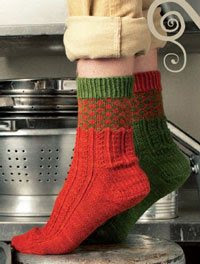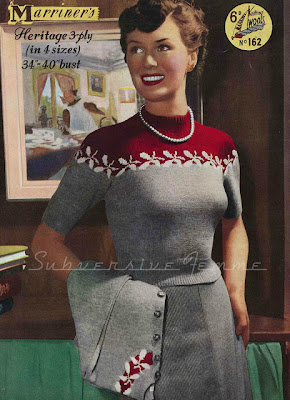Interweave, which gave us Jane Austen Knits, has taken its next foray into literary-themed knitting and published The Unofficial Harry Potter Knits 2013. Before you Harry Potter enthusiasts get too excited, I must tell you that due to copyright restrictions, the print version of the magazine is only available for sale in the U.S. If you are American or, um, reside elsewhere but have an obliging American friend or family member who will accept mail for your and resend it to wherever you live, you can buy The Unofficial Harry Potter Knits 2013 here. Alternatively, I understand that the digital version is available to anyone registered as a U.S. resident.
Harry Potter does seem like a great choice for a literary tie-in. The world of the books and the movies has many great costumes and symbols and other visuals that lend themselves to knitwear design. And knitting itself appears in the books with some regularity. As Amy Clarke Moore has written in her Editor's Letter for the issue, "J. K. Rowling is a knitter herself and several of her characters knit — from Hagrid (making a canary-yellow circus-tent) to Molly Weasley (knitting sweaters for all her children) to Hermione (making hats for house-elf liberation). Even Dumbledore contemplates the value of a nice warm pair of socks and enjoys reading Muggle knitting publications."
Let's have a look at the designs in The Unofficial Harry Potter Knits 2013.
These are the Albanian Forest Mitts, which are very handy for keeping one's hands warm while flying on a broomstick, wielding one's wand, or retrieving one's mother's stolen diadem. They're reasonably wearable from a Muggle standpoint too.
This is the Bluebell Flames shawl, which is meant to represent the bright blue fire conjured by Hermione Granger in Harry Potter and the Philosopher’s Stone. It's an attractive shawl, and just like the bright blue flames, it'll keep you warm on your own quests, such as commuting to work.
These are the Dragon's Egg socks, a reference to the golden dragon's egg Harry retrieves as the first task in the tri-wizard tournament in Harry Potter and the Goblet of Fire.
This is Dumbledore's Smoking Hat, but you don't have to be smoking or have a crazy neckbeard to wear this it. It's totally cute without being twee and I'd wear it myself.
In Harry Potter and the Philosopher’s Stone, Dumbledore laments that he has once again received books for Christmas, when what he really wanted was a pair of warm woolen socks. Interweave has obliged by publishing a design for the perfect Dumbledore Socks, with his initials “A P W B D” (Albus Percival Wulfric Brian Dumbledore) worked around the top. If you're not a Dumbledore fan, you could always replace them with your own initials.
This is the E.L.F. Cap, which of course is based on the hats and other items Hermione knitted and left temptingly about for the house elfs to take so they could be set free. To her disappointment, the elves wouldn't touch them, with the exception of Dobby, who happily wore a stack of them. But then the things Hermione made were described as not being very well-made or very attractive. Maybe if she'd been as gifted in knitwear design as she was in her studies, the outcome might have been different. At any rate this would be a cute thing to make for the little elf in your life who is too young to appreciate the more evocative patterns in this issue and just wants a more literal Harry Potter knit.
The Forbidden Forest Scarf. Wearing this would drive me crazy — all those dangling ends. And no one would get the reference. The scarf does have a certain textural interest and I suppose it wouldn't be a bad piece if stitched unobtrusively together and worn with the right modern outfit.
These are the Fred and George Socks. Now your feet can be like the Weasely twins: paired, but different.


This is Ginny's Cardigan. I love this beautiful, classic design, with its subtle but definite rendering of owl faces in the lace work down the back. And I'm not alone in my love for this pattern, as it has gotten more favourites on Ravelry than any other pattern from this issue, and there's a knitalong for it.
This is the Hagrid Sweater, designed for the larger-than-life man in your life.


This is the Heliopath Vest, which is the designer's idea of what Luna Lovegood would make for herself. I quite like this pattern on the whole, but I am not crazy about the dropped stitch effect. Dropped stitches generally look mistaken rather than effective, and this isn't one of the exceptions.
This is the Herbology Socks pattern, and they're just the thing to wear when one is repotting asphodels.
Hermione’s Time-Turner Mitts. These are cute and wearable. If you don't feel like being asked what the "H" stands for, you can always use your own initial instead.
This is the Ignotus Peverell's Cloak, which unlike the Ignotus Peverell's Cloak of Invisibility does not turn one invisible. Speaking as a Muggle and assessing it from the standards one expects of visible items of apparel, I find it rather frumpy.
The Juicy Fly pattern is based on the black velvet hairbow Dolores Umbridge is wearing when Harry Potter meets her, and that he mentally compares to a succulent fly. I don't know whether anyone would actually want to bother making this one as it's not much use. A little girl might wear it in her hair, I suppose, but then you could find other more attractive hair bow patterns to make that she'd rather wear.


This is the Lestrange Cloak, and it is by far my favourite of any pattern in this magazine. It is just stunning and would look lovely and elegant over a simple short dress for any relatively dressy occasion.
The Malfoy Manor Wrapper. I very much like this design. I don't think I've ever seen a shrug that fastens in the front, and it really works here because the lines are so good. Also, this item will stay in place.
This is the Mermaid's Shawl pattern, inspired by the mermaid song in Harry Potter and the Goblet of Fire. It's really lovely and any mermaid would be proud to wear it. Wool will keep one warm even when wet, after all.
The Modern Stripes House Scarves design are successful both as a Harry Potter reference item (they can of course be knitted in any house colours one wishes) and as a very sharp, appealingly modern design. I also love that Interweave has gone to the trouble to get models who look like the Harry Potter characters and to style them so as to enhance the effect. It was going the extra mile and the effort has really paid off.
This is the Mudblood Cardigan, and of course it's a simple cardigan such as a Muggle might wear and just the sort of thing Hermione Granger might have worn when she arrived at Hogwarth's; a Muggle-born but with more talent and brains than anyone else in her class. It's a nice-looking basic sweater, though I would make it with a little more ease than has been allowed this Hermione-like model.
The Narcissa Socks are, according to the design's Ravelry page, "inspired by the dark beauty of Narcissa Malfoy with twisted stitches and intricate petal motifs". I must admit they do have that effect. The characters of the Harry Potter world do seem to need a lot of socks, but I guess that's to be expected when they spend so much time in drafty castles and flying through the cold night air.


These are the O.W.L. Mittens, with spells inscribed conveniently on the palms. Very cute and inventive pattern.
This is the Order of the Phoenix Winged Vest, and that is one intricate and gorgeous design on the back. It's a man's pattern, and though of course many men would not care to wear this, there are probably not a few who like Harry Potter and/or a touch of the unusual and dramatic in their clothes who would.
I'm not crazy about the Pomona Mitts. They're meant to reflect Professor Pomona Sprout’s personality, which is "earthy, robust, and ready for hard work". And probably they do, but by Muggle standards they just look rough and amateurish.
The Severus Pullover is another gorgeous design that was imagined as something "Professor Snape might wear if he needed to go undercover as a Muggle". As with the owl design in Ginny's Cardigan, the serpentine pattern has been kept subtle. Even the most conservative, kid-culture eschewing man might wear this, never dreaming that he's unwittingly a representative of Slytherin House.
Love the Sorcerer's Sweater, with its intricate and original cabled design.
These are the Sword of Gryffindor Mitts, and I quite like them as well. They have a certain casual elegance to them, and yet they'd be warm and fairly practical.
The Gray Lady's Cloak pays homage to the ghost of Ravenclaw. It's quite pretty overall, though I am not thrilled with how the hood sits. It's more than a little baggy.


The Tonk's Togs design was inspired by Nymphadora Tonks’s ability to change her appearance at will; it's two sweaters designed to be worn together or apart. And I quite like both sweaters, especially the cabled design with the asymmetrical neck, which is obviously the product of considerable design chops, but I don't think it makes much sense on either a practical or aesthetic level to wear them together.
This is the Tracery pattern, which of course resembles the stained glass windows that might be found at Hogwarts. I loved stained glass (I do some stained glass work myself), and this is a brilliant rendering of the effect of medieval stained glass windows, as translated into knitting.
The Yule Ball Engageantes are meant to be elegant enough to be worn with a ball gown. I think they'd need to be knitted in a more delicate fibre and/or tint to succeed at being ball gown-worthy because here it looks like they've been knitted in sock yarn which is not an upscale look. They are however a quite well-rendered pattern and would give a bit of style to autumnal streetwear.
































































